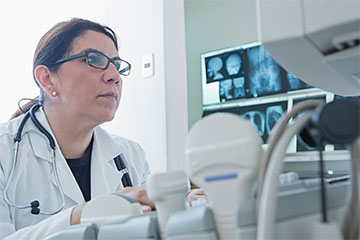What is an Ultrasound?

You may be familiar with ultrasounds as a part of routine prenatal care. Pregnant women often receive ultrasounds in order to monitor the fetus as it develops, and because sonography is non-invasive, it is safe for both mother and child.
Ultrasounds are also used to visualize other parts of the body, from muscles and tendons to internal organs. This technology is widely employed as a diagnostic tool by radiologists and sonographers to capture the size and structure of organs. Ultrasounds can also help determine the composition of any masses or tumors detected within the body.
How are Ultrasounds Used?
Ultrasound can be used as a diagnostic imaging tool. There are also therapeutic ultrasounds, which are a new, non-invasive technology used to treat blood clots and tumors.
Diagnostic Ultrasounds
Diagnostic ultrasounds use probes called transducers to generate images of structures within the body. These transducers come in many shapes and sizes and emit high-frequency sound waves that are translated to images via computer.
Most ultrasounds are performed with the transducer placed against your skin. Sometimes an internal ultrasound may be required to help diagnose gynecological and other issues. As the sound waves bounce off organs and tissues, they create echoes that can be interpreted as real-time images. Because these specific sound waves are not able to travel through air, it is important for the technologist to apply a special ultrasound gel to your skin before using the transducer in order to achieve an image.
The intensity of these "echoes" changes based on the density of the tissue being scanned — for example, a fluid-filled cyst may appear darker by sonogram because it is less dense than a solid mass, which shows up brighter on the screen. Using ultrasound technology, a sonographer can view the inner-workings of your body in great detail, from organ and tissue structure down to the movement of blood through your blood vessels.
Therapeutic Ultrasounds
Therapeutic ultrasounds are used to modify or destroy tissue, such as blood clots, kidney stones or tumors using a process called thermal ablation. The benefit of therapeutic ultrasound as a non-invasive therapy is still being studied, though patients generally prefer the lack of incisions and recovery time when compared to traditional surgery. Unlike diagnostic ultrasounds, therapeutic ultrasounds are only performed as interventional radiology procedures in one of our hospitals.
What Are the Types of Diagnostic Ultrasounds?

- Pelvic ultrasounds are focused on the structures and organs of the lower abdomen and pelvis. There are two types of pelvic ultrasound: transabdominal and transvaginal (for women). These exams are frequently used to evaluate the reproductive and urinary systems.
- Abdominal ultrasounds scan the upper abdominal area. They are often used to help diagnose pain or discomfort of the liver, gallbladder, bile ducts, pancreas, kidneys, spleen and abdominal aorta.
- Obstetric ultrasounds produce sonogram images of an embryo or fetus within a pregnant woman, as well as the mother's uterus and ovaries. These ultrasounds, which do not use radiation, are the preferred imaging method for monitoring pregnant women and their unborn babies. Doppler ultrasounds, which evaluate blood flow in the umbilical cord, fetus or placenta, may also be part of this exam.
- Carotid ultrasounds are used to monitor the carotid arteries in the neck that carry blood from the heart to the brain. Doppler ultrasounds are also included in this exam. Carotid ultrasounds are commonly used to screen patients for a condition called stenosis, which is a blockage or narrowing of the carotid arteries that may increase the risk of stroke.
- Musculoskeletal ultrasounds evaluate muscles, tendons, ligaments and joints throughout the body. This procedure can help your physician diagnose sprains, strains, tears and other soft tissue conditions, as well as, evaluate your need for physical or occupational therapy. Musculoskeletal ultrasounds are sometimes used to help physicians conduct guided steroidal injections for managing inflammation.
- Breast ultrasounds can show all areas of the breast, including the area closest to the chest wall, which can be hard to evaluate with a traditional mammogram. This exam is particularly useful when paired with a mammogram as part of a standard breast cancer screening. Imaging doctors called radiologists use breast ultrasounds to help determine if a detected mass in the breast is solid (potentially malignant) or fluid-filled (typically benign).
Why Should I Get an Ultrasound?
Perhaps the biggest benefit of ultrasound over other imaging modalities is the lack of ionizing radiation used during exams. This makes ultrasound a relatively safe alternative for pregnant women, young children and those who cannot otherwise receive diagnostic imaging. Ultrasound equipment is also very portable, allowing ultrasound technologists to scan patients with mobility issues.
Parents with young children (who may feel uneasy about being inside an MRI machine), or anyone who suffers from claustrophobia, will also appreciate the relative ease and comfort of an ultrasound exam. In addition, ultrasound exams tend to be less expensive overall when compared to other types of diagnostic imaging such as MRI, CT and PET.
At Memorial Hermann, we recognize the important role that ultrasound can play in ensuring the accuracy of your diagnosis. That’s why we do our best to keep out-of-pocket costs for ultrasounds as low as possible. As with any test or medical procedure, we recommend you check with your insurance provider to ensure specific exams are covered under your current plan.
Are There Risks Associated with an Ultrasound?
Ultrasound has been used as a safe and effective imaging procedure for over 35 years. In that time, no known biological side effects have been observed in patients. Despite this stellar safety record, the FDA still recommends the “prudent use” of ultrasound imaging and discourages patients from undergoing exams unless they are medically necessary.
While it is not necessarily a risk, keep in mind that ultrasounds cannot fully replace other imaging types. For example, ultrasound images may not be as detailed as those from a CT or MRI scan for certain indications, and high-frequency sound waves cannot travel through dense structures like bone, making X-rays a more viable option. Talk with your doctor if you have any questions or concerns about which imaging technique is right for you.
What Should I Expect from an Ultrasound Exam?
Ultrasound exams are simple outpatient procedures. They are non-invasive, relatively painless and take very little time to complete.
If your doctor has ordered an ultrasound, you may be wondering what to expect. To learn what to expect and how you should prepare for an ultrasound exam as well as how long it typically takes to receive your results, click here/what happens during an exam Your doctor can also provide more specific information about an ultrasound.
How Do I Prepare for an Ultrasound?
Compared to exams like MRI, which may require an IV or the ingestion a barium contrast solution prior to scanning, ultrasounds need little to no preparation.
There are a few minor exceptions, including:
- Abdominal or gallbladder ultrasounds require no eating or drinking for 6-8 hours before your exam. This helps the ultrasound technologist to take clearer scans of the targeted area.
- Pelvic, renal or obstetrical ultrasounds may require you to drink enough water to fill your bladder for the same reason. In these cases, you may be permitted to use the bathroom to empty your bladder before additional images are obtained.
What to Expect During an Ultrasound

Depending on the type of ultrasound exam you receive, you may be asked to undress and put on a hospital gown in a private changing room before the procedure begins. Once you are lying on the examination table, our registered ultrasound technologist will use a handheld transducer to perform the ultrasound. A clear gel will be applied to your skin to help the transducer pick up sound waves as it moves back and forth over the area being scanned. For your added comfort, all Memorial Hermann Imaging Centers are equipped with ultrasound gel warmers.
There will be light pressure from the transducer, but you should feel little to no discomfort unless the area is tender. As the technologist performs the procedure, they will move the transducer around to obtain high quality images of the entire area. You may be asked to change positions slightly or even hold your breath in order to get a clearer image.
Once the exam is finished, the technologist will wipe off the ultrasound gel. Any remaining gel will dry quickly and will not stain or discolor your clothing.
How Long Does an Ultrasound Exam Take?
At Memorial Hermann, we understand that your time is very important, and we do our best to make sure each exam is quick and thorough. A standard ultrasound procedure should take no more than 30 to 45 minutes, from check-in to exam completion.
When Can I Expect My Results?
Sonogram images from your ultrasound will be sent for immediate analysis to one of our affiliated radiologists. Once they have interpreted the images, a full report will be sent to your physician who ordered the exam. This process usually takes about 2-3 business days. Your doctor may schedule a follow-up appointment with you to go over the results.
Why Choose Memorial Hermann for Your Ultrasound?
When it comes to the health and safety of you or your loved ones, you expect nothing less than the best care available, and at Memorial Hermann, we’re committed to providing you with an unparalleled level of diagnostic services. Memorial Hermann Imaging Centers are also conveniently located at over a dozen locations across the Greater Houston area.
Schedule an Ultrasound Appointment
You can now schedule an ultrasound online at many of our locations. Call (877) 704-8700 today to schedule an ultrasound appointment, or you can schedule your appointment online.